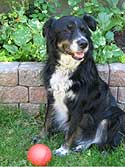 | Rico's Rich Vocabulary |
 | Rico's Rich Vocabulary |
|
By Ellen Kuwana Neuroscience for Kids Staff Writer July 14, 2004 Rico, who is approximately 16-inches tall and lives in Germany, knows all the names of his 200 or so toys and balls. Ask him to "get the panda," and he'll happily run and get it for you. When asked, he will also bring you his little red doll or blue dinosaur. Rico is so talented that he's been on TV, which is how researchers learned of him. Julia Fischer and other psychologists at the Max-Planck Institute for Evolutionary Anthropology in Leipzig, Germany, asked to study him in action. They set up experiments in his house, to test how many words he really knew.
Testing Word Recognition
Testing Word Learning ("Fast Mapping"*)* Quickly guessing a word's approximate meaning is referred to as "fast mapping." This ability has yet to be demonstrated in nonhuman primates such as chimpanzees. Not only does Rico recognize words, but it seems that he can learn a new word the first time he hears the word. The researchers placed a novel object (one Rico had never seen) with seven familiar objects. When told to fetch the new item, Rico figured it out seven out of 10 times. In humans, the ability to identify a new object by the process of elimination develops around the age of three years.
The next step for Rico and the researchers is to try to figure out how much of phrases he understands. For example, he can be instructed to put a certain toy in a box, or bring a certain ball to a person. This research sheds light on how language is learned. In dogs at least, language production (talking) is separate from language comprehension (understanding). "You don't have to be able to talk to understand a lot," says Fischer. |
Did you know? The author's dog, Tali Photo credit: Ellen Kuwana |
|
|
References and Further Information:
|
| GO TO: | Neuroscience In The News | Explore the Nervous System | Table of Contents |
![[email]](./gif/menue.gif) Send E-mail |
 Fill out survey |
 Get Newsletter |
 Search Pages |
 Take Notes |